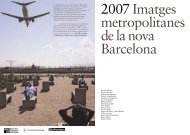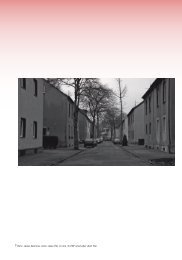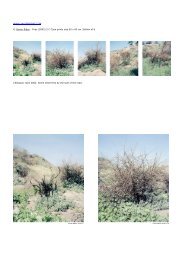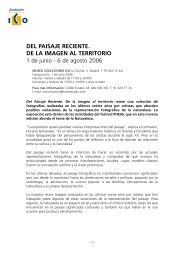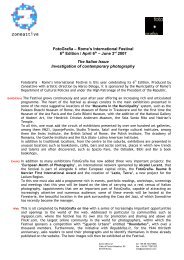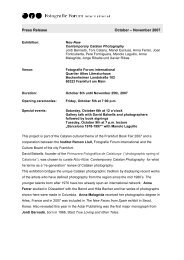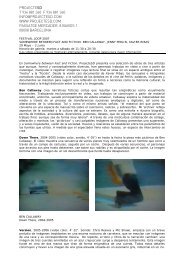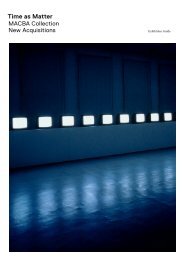Xavier Ribas Concrete Geographies [Nomads] Xavier Ribas's ...
Xavier Ribas Concrete Geographies [Nomads] Xavier Ribas's ...
Xavier Ribas Concrete Geographies [Nomads] Xavier Ribas's ...
Create successful ePaper yourself
Turn your PDF publications into a flip-book with our unique Google optimized e-Paper software.
stubborn, slow growth of plant-life in the rubble<br />
<strong>Nomads</strong> is a work that seems to ask these questions of itself. Better still, it enacts these questions with all their<br />
implicit uncertainty and doubt, against the grain of documentary traditions. It is an embodied vision as much as a<br />
revelatory one. Beside a vision of the site itself, what we also see in <strong>Nomads</strong> is the site's impositions upon the<br />
camera-connected-body, and upon the very liberties of possible perspective.<br />
In <strong>Xavier</strong> <strong>Ribas</strong>’s photographs, the ground seems to sear up like a wall. And as viewers, we are kept tightly and<br />
inescapably bound to it, drawn to its limits. Within these confines, it’s as though the camera searches for<br />
something, some clue, some definitive remnant, or any such 'thing' that might invite a notion of history (that<br />
'spark of contingency' that Walter Benjamin once wrote of). Nothing comes. Nothing, that is, apart from the weeds<br />
and the material fractures in disturbed foundations of the site. It’s the particular kind of nothing that has a<br />
disorientating, almost suffocating effect.<br />
In those few photographs that pan upward to a broader view, we find ourselves confronted with the blank and<br />
faceless windows of overlooking industrial units. Every space that promises a breathing space is a space occupied<br />
and pre-seen. The graffiti tags on the surrounding walls make their authoritive claims upon the site in altogether<br />
different sense. The sky appears in small, inorganic slivers, as grey and as dead as the concrete on the ground. All<br />
life, apart from the weeds, seems to be in a state of evasion. Viewing this work, we become acutely aware of how<br />
architecture can act against us, upon our own bodies as spectators, but also implicitly upon the bodies that have<br />
suffered this environment at first hand.<br />
The presentation of these photographs in a grid format offers some reconstitution. A comparative and formal<br />
containment of discreet fragments, the grid format also provides the hope of awakening the muted voices of recent<br />
history and the enclaves of community. The grid structure, of course, refers to the well-known organisational<br />
strategy that exists at both ends of the speculative divide, between the urban plan and the archeological search.<br />
The satellite navigation co-ordinates and Google Earth composite images provide some specificity and exteriority to<br />
these interior planes of vision of the grid. The Google-Earth images show a rectangular shape that is the subject of<br />
these photographs; a space that is scarred in different shades of grey, looking like some kind of ancient relic<br />
against the uniform structure of rooftops and road and rail networks that define the surrounding urban fabric. This<br />
is a space that, in effect, seems to belong to another order of time, layered with our own.<br />
The day is bright, as we can see on some images. And on a day like this there are surely numerous people less<br />
than a kilometer from here, pointing their cameras to the horizon, cutting their photographic frames in neat<br />
rectangles of sea and sky, before getting on with their day. How long has it been now Three or more years since<br />
the foundations of this site were shaken, there weeds are taking over. The clouds brooding overhead are a signal<br />
that it’s going to rain, and soon the bright concrete blotches with water drops.


![Xavier Ribas Concrete Geographies [Nomads] Xavier Ribas's ...](https://img.yumpu.com/36327519/2/500x640/xavier-ribas-concrete-geographies-nomads-xavier-ribass-.jpg)
